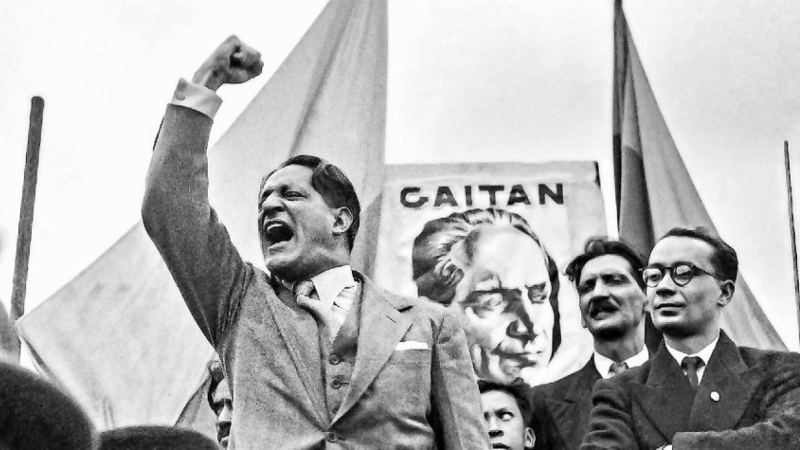The assassination of Jorge Eliécer Gaitán on April 9, 1948 can be seen as a response to the attempt to deepen democratic reforms promoted slowly in the previous liberal governments, which were stopped with repression and violence by the conservative elites.
76 years later, Colombia a “government of change”, which claims to be the heir and successor of Gaitán’s ideas in favor of the working class sectors that have been the hardest hit by the war and who hope to be included in future peace agreements.
The early life of Gaitán
Born in the neighborhood of Las Cruces, in Bogotá, Jorge Eliécer Gaitán’s father was a bookseller and his mother was a teacher, who educated him until he was twelve years old. Gaitán became a man of ideas early on.
His passion for reading and writing quickly brought him closer to politics from his profession as a lawyer who graduated from the National University, where he graduated with his thesis: “Socialist Ideas in Colombia.”
After completing his doctorate and graduating with honors in Italy, he returned to Colombia in 1928, a critical moment due to the workers’ uprisings and the violent repression imposed by the Abadía Méndez government.
As a representative to the House of Representatives for the Liberal party, he defended workers in the banana zone from the abuses of the United Fruit Company at that time. With his debates and after achieving several compensations he became a popular leader known throughout the country.
He had a solid political career within the Liberal Party, and founded his movement National Union of the Revolutionary Left (UNIR). In 1936 he was elected mayor of Bogotá and in 1940 was named Minister of Education.
In the last years of his career, he became the leader of the Liberal Party despite the rejection of the elite faction of the party, and at the same time he denounced the “chulavita” (right-wing paramilitaries) and conservative violence that was beginning to brew in the fields after the liberal reforms implemented in that period.
The impact of the Gaitán crime
His great sympathy among the working classes led him to organize the “March of Silence” at the beginning of 1948, to demand that President Mariano Ospina stop ignoring right-wing paramilitary violence in the countryside. This mobilization marked a milestone in national history by concentrating nearly 100,000 people “mourning” and in silence in the Plaza de Nariño.
His speeches against the oligarchy and in favor of the excluded made both the Conservative and Liberal elites uncomfortable. By that time it was clear that Gaitán could win the presidency.
On April 9, 1948, he was murdered in the center of Bogotá when he went out to lunch.
In response, Bogotá was set on fire in a popular revolt. The people launched an insurrection against the Nariño Palace, businesses were looted, the church, the Palace of Justice, the Government, and the headquarters of the conservative press were burned, while the National Radio Station was taken over to promote the uprisings throughout the country.
Military tanks prevented the capture of the Palace with indiscriminate machine gun fire on protesters. Many police officers and soldiers, seeing themselves outnumbered, surrendered to the popular cause.
The final toll was more than 3,000 people killed and a hundred buildings destroyed.
The war in fields and cities
In the countryside, the bipartisan war intensified, which years later, after the betrayal of the peace agreements with the liberal guerrillas and the continuous State repression against the most excluded classes, led to the emergence of the revolutionary insurgency with the appearance of several left-wing guerrilla movements: the National Liberation Army (ELN), the Revolutionary Armed Forces of Colombia (FARC) and the Popular Liberation Army (EPL).
Decades later, new actors in the conflict appeared, promoted from within the State. Paramilitarism emerged as a counterinsurgency strategy, with drug trafficking as its financier, and military support from the United States. This worsened the conflict that today persists in all areas of life.
Day of Remembrance and Solidarity with Victims
In June 2011, the Victims and Land Restitution Law in Colombia was approved, which in its article 142 established April 9 as the Day of Remembrance and Solidarity with Victims.
The Truth Commission, the Special Justice for Peace (JEP) and the Human Rights Violations Data Analysis Group (HRDAG) have presented reports indicating that the conflict has left nearly eight million victims, among them are 450,664 homicides reported between 1985 and 2016, where 80% of those victims were unarmed civilians.
The groups which carried out the majority of these crimes were paramilitaries, responsible for 45% of victims. The report of these institutions indicates that 121,768 people were disappeared between 1985 and 2016 by right-wing paramilitary groups.
According to the Memory Center, from 1958 to 2021, 179,076 selective murders and 4,237 massacres have been recorded. For its part, the Single Registry of Victims (RUV), Colombia has a historical total of almost 8,219,403 forcibly displaced due to events that occurred from 1985 to December 31, 2021.
In recent decades, the JEP found that in the two governments of Álvaro Uribe, between 2002 and 2008, at least 6,402 victims of extrajudicial executions were registered.
On the other hand, reports from INDEPAZ affirm that since the signing of the peace agreement, the number of murdered social leaders is close to 1,600.
The United Nations also pointed out that since the signing of the Havana peace agreements in 2016, more than 400 demobilized guerrilla fighters have been killed.
This article was translated from an article originally published in Spanish on Colombia Informa.





